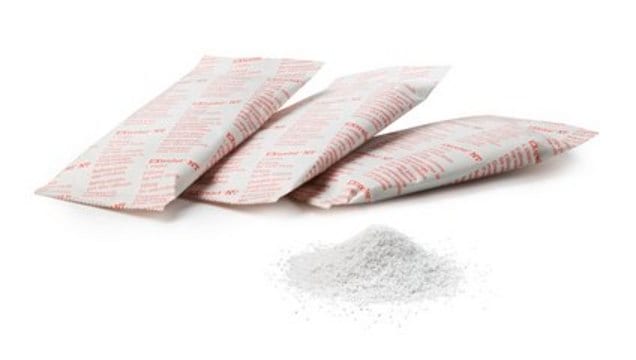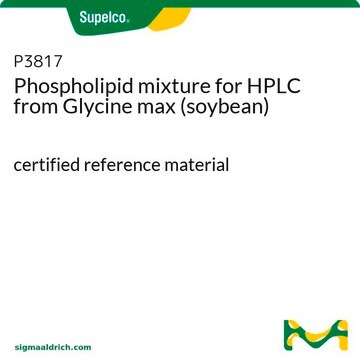55261-U
HybridSPE®-Phospholipid solid phase extraction (SPE) Cartridge
Cartridge, bed wt. 30 mg, volume 1 mL, pk of 100
Synonim(y):
HybridSPE (phospholipid and protein removal) SPE cartridge tube, 1 mL
About This Item
Polecane produkty
product name
HybridSPE®-Phospholipid, Cartridge, bed wt. 30 mg, volume 1 mL, pk of 100
Materiały
PE frit (20 μm)
polypropylene hardware
linia produktu
HybridSPE®
skład
bed wt., 30 mg
opakowanie
pk of 100
metody
solid phase extraction (SPE): suitable
pojemność
1 mL
grupa aktywna macierzy
zirconia-based phase
Szukasz podobnych produktów? Odwiedź Przewodnik dotyczący porównywania produktów
Opis ogólny
The "In-well" and "In-cartridge" precipitation methods are available for the HybridSPE-Phospholipid 96-well version and HybridSPE-Phospholipid Ultra cartridge in which biological plasma/serum is first added to either the well or cartridge, followed by acidified acetonitrile (precipitation agent). After a brief mixing/vortexing step, vacuum is applied. Because the 96-well and Ultra cartridge versions contain a series of low porosity hydrophobic filters/frits, the packed-bed filter/frit assembly acts as a depth filter facilitating the concurrent removal of both phospholipids and precipitated proteins during the extraction process. Standard HybridSPE-Phospholipid cartridges require an "off-line" precipitation method.
Zastosowanie
- Less is more: a methodological assessment of extraction techniques for per- and polyfluoroalkyl substances (PFAS) analysis in mammalian tissues.: This study assesses various extraction methods, including HybridSPE®-Phospholipid, for analyzing PFAS in tissues, highlighting efficiency and reproducibility (Mertens et al., 2023).
- Rapid analysis of 65 pharmaceuticals and 7 personal care products in plasma and whole-body tissue samples of fish using acidic extraction, zirconia-coated silica cleanup, and liquid chromatography-tandem mass spectrometry.: This paper describes a rapid analytical method incorporating HybridSPE®-Phospholipid for sample preparation, demonstrating its application in environmental toxicology (Tanoue et al., 2020).
Cechy i korzyści
- For use in conjunction with off-line protein precipitation.
- Merges the simplicity of protein precipitation and the selectivity of SPE via the targeted removal of phospholipids
- Reduce ion-suppression through the complete removal of phospholipids and precipitated proteins
- 2-3 step generic procedure
- Minimal to no method development
- Available in 96-well and 1 mL cartridge dimensions
Informacje prawne
Zastosowanie
produkt powiązany
Kod klasy składowania
11 - Combustible Solids
Klasa zagrożenia wodnego (WGK)
WGK 3
Temperatura zapłonu (°F)
Not applicable
Temperatura zapłonu (°C)
Not applicable
Choose from one of the most recent versions:
Masz już ten produkt?
Dokumenty związane z niedawno zakupionymi produktami zostały zamieszczone w Bibliotece dokumentów.
Klienci oglądali również te produkty
Produkty
This Sigma-Aldrich article continues to detail new methodology for the analysis of Vitamin D metabolites using HybridSPE-Phospholipid technology.
Ten artykuł Sigma-Aldrich omawia działanie technologii HybridSPE-Phospholipid i sposób usuwania fosfolipidów.
An article focusing on ion-suppression and phospholipid contamination and some of their major causes and difficulties.
This Sigma-Aldrich article discusses how the HybridSPE-Phospholipid Technology works and how the phospholipids are removed.
Protokoły
A simple method to enrich phospholipids from plasma samples, involving a HybridSPE-PPT 96-well plate that both retains phospholipids and removes precipitated proteins.
Powiązane treści
Small molecules are ions and compounds of molecular weight typically less than 900 daltons. These compounds can be effectively separated and analyzed by HPLC, UHPLC and LC-MS using mainly silica particles or monolithic stationary phases with a broad range of column chemistries (modifications).
Małe cząsteczki to jony i związki o masie cząsteczkowej zazwyczaj mniejszej niż 900 daltonów. Związki te mogą być skutecznie rozdzielane i analizowane za pomocą HPLC, UHPLC i LC-MS przy użyciu głównie cząstek krzemionki lub monolitycznych faz stacjonarnych z szerokim zakresem chemii kolumn (modyfikacje).
Chromatograms
application for HPLCNasz zespół naukowców ma doświadczenie we wszystkich obszarach badań, w tym w naukach przyrodniczych, materiałoznawstwie, syntezie chemicznej, chromatografii, analityce i wielu innych dziedzinach.
Skontaktuj się z zespołem ds. pomocy technicznej











